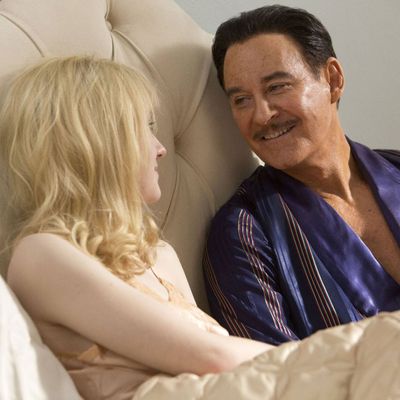
Kevin Kline is almost too good a fit for the aging Errol Flynn in the story of Flynn’s final affair — with a 15-year-old girl — in The Last of Robin Hood. Kline became a star onstage as the swashbuckling pirate king in The Pirates of Penzance and played Douglas Fairbanks in Chaplin, and here he seems ready to hang once more from the mizzenmast and declare his dominion over the high seas. Kline has the right faux Brit accent (Flynn was born in Australia) and debonair quiver of the head, and his lies fall so charmingly from his mouth that they scarcely seem like lies: The seduction is all. But if Flynn had much of an inner life, the movie doesn’t show it: This is a man for whom the mask has supplanted the face. It’s certainly understandable that he could lust after the dewy blonde Beverly Aadland (Dakota Fanning). But why he falls in love — true love — seems outside the film’s purview.
The writer-director team of Richard Glatzer and Wash Westmoreland take a morally neutral stance toward Flynn’s seduction of Beverly (at the time, Flynn reportedly believed she was 18), but that’s not their real focus. The character who conjures up their wonder and horror and pity is Beverly’s dipsomaniacal mother, Florence, played with breathtaking complexity by Susan Sarandon. An ex-dancer who lost part of a leg in an accident, Sarandon’s Beverly is a study in passive complicity. She doesn’t push her daughter into Flynn’s arms — she doesn’t need to — but her naïveté about the nature of the relationship is her brand of showbiz cunning. Sarandon pops her big eyes and flutters her false eyelashes and savors Flynn’s seduction of her, visibly buoyed by the actor’s attentions. The Last of Robin Hood is told from Florence’s perspective: She’s talking (after Flynn’s death) to reporter Tedd Thomey (Jason Davis), with whom she collaborated on a notorious memoir called The Big Love. The book was written without Beverly’s knowledge or consent, which is the ultimate tragedy. It was Florence’s last chance at the spotlight, and she swallowed hard and betrayed her daughter.
Fanning plays Beverly as an unformed, washed-out girl with no perceptible talent who’s swept along by strong-willed people. It’s a small, sweet-tempered performance, but the part is thin. In life, Flynn evidently tried to get Beverly cast as Lolita to his Humbert Humbert, and in the film, he angrily informs Stanley Kubrick (an amusingly earthy Max Casella) that he and Beverly are a package. Was he that blind? The real Beverly must have had something — though you can’t, admittedly, see it in the film Flynn wrote and produced for her, the dire 1959 pro-Castro saga Cuban Rebel Girls.
The film is too wan and distanced to sweep you up, but it holds you, and it doesn’t — unlike most Hollywood biopics — leave you feeling as if you need a shower. (That might or might not be a good thing, given the subject.) There is one mesmerizing scene. To sell his precious yacht for needed funds, Flynn and Beverly travel to Vancouver, where the actor has a spasm of pain in the prospective buyer’s office. A doctor agrees to see Flynn at his house, but when Flynn arrives, he can’t resist holding forth before the assembled guests, acting out a story about John Barrymore’s corpse, all color gone from his face but his performer’s blood to the end running high.


